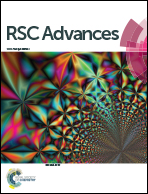Pennyroyal and gastrointestinal cells: multi-target protection of phenolic compounds against t-BHP-induced toxicity
Abstract
Herbal teas are consumed for their valuable content of bioactive phytochemicals. This work represents the first attempt to establish a linkage between the chemical composition of pennyroyal (Mentha pulegium L.) infusion and its potential to prevent cellular oxidative stress. The phenolic profile was established by HPLC-DAD-ESI/MSn, twelve out of fifteen compounds being identified for the first time in this species. The infusion presented a phenolic content of 122.92 mg g−1 (lyophilized extract) and a remarkable antiradical activity. A reduced glutathione detoxification mechanism was demonstrated to be involved in human epithelial colorectal adenocarcinoma (Caco-2) cell resistance against tert-butyl hydroperoxide-induced toxicity, while the same was not observed for human epithelial gastric adenocarcinoma (AGS) cells. For the first time, the presence of these phenolic compounds inside the cells was confirmed by 2-aminoethyl diphenylborinate (DPBA) phenol fluorescence dye staining, suggesting a direct antioxidant effect. M. pulegium infusion seems to provide bioactive compounds able to maintain a proper antioxidant balance in gastrointestinal cells.


 Please wait while we load your content...
Please wait while we load your content...